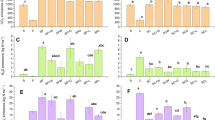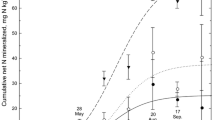Abstract
Incorporation of spring-applied manure is known to reduce N volatilization losses and hence increase the N value of the manure. However, traditional incorporation methods are not compatible with reduced-tillage systems requiring minimum residue coverage of 30 %. Here, eight New York dairy farms participated in 2008 in a 2-year on-farm trial. This trial was designed to test the hypothesis that shallow mixing of soil involving aerator incorporation of spring-applied manure is as effective as chisel incorporation of manure in conserving manure N for corn (Zea mays, L) uptake while retaining more surface residue. The eight fields selected for this trial varied from first to third year corn after hay and had varying manure histories. All fields were subjected to a randomized complete block design with four replicates comparing surface application of manure, as control, shallow incorporation of manure with an aerator, and chisel incorporation of manure. Starter N applications were 39 kg N/ha or less, and manure application rates ranged from 51 to 112 kL/ha. Results show that shallow incorporation of manure significantly reduced soil disturbance and retained, on average, 30 % more surface residue cover than obtained with chisel incorporation. Chisel and aerator-based incorporation resulted in similar soil nitrate levels at 13 of 16 site years, suggesting similar levels of N conservation. Across all sites and years, incorporation increased silage yield by 0.9–1.5 Mg DM/ha, independent of incorporation method. Based on these results, we show that shallow mixing of soil and spring-applied manure is a suitable option for conserving N and maintaining greater surface residue coverage without compromising on yield or silage quality.


Similar content being viewed by others
Abbreviations
- CSNT:
-
Corn stalk nitrate test
- DM:
-
Dry matter
- ISNT:
-
Illinois soil nitrogen test
- PSNT:
-
Pre-sidedress nitrate test
References
AOAC (2000a) Protein (crude) in animal feed. AOAC-990.03. In: Official methods of analysis of the Association of Official Analytical Chemists, 17th edn. AOAC, Arlington
AOAC (2000b) Urea and ammoniacal nitrogen in animal feed. AOAC 941.04. In: Official methods of analysis of the Association of Official Analytical Chemists, 17th edn. AOAC, Arlington
AOAC (2000c) Ash of animal feed. AOAC-942.05. In: Official methods of analysis of the Association of Official Analytical Chemists, 17th edn. AOAC, Arlington
AOAC (2006) Crude fat in feds, cereal grains and forages. AOAC-2003.05. In: Official methods of analysis of the Association of Official Analytical Chemists, 18th edn. AOAC, Arlington
Binford GD, Blackmer AM, El-Hout NM (1990) Tissue test for excess nitrogen during corn production. Agron J 82:124–129. doi:10.2134/agronj1990.00021962008200010027x
Bittman S, van Vliet LJP, Kowalenko CG, McGinn S, Hunt DE, Bounaix F (2005) Surface banding liquid manure over aeration slots: a new low-disturbance method for reducing ammonia emissions and improving yield of perennial grasses. Agron J 97:1304–1313. doi:10.2134/agronj2004.0277
Brown LC, Wood RK, Smith JM (1992) Residue management demonstration and evaluation. Appl Eng Agric 8:333–339
Chen Y, Zhang Q, Petkau DS (2001) Evaluation of different techniques for liquid manure application on grassland. Appl Eng Agric 17:489–496
Cornell Cooperative Extension (2013) 2013 Cornell Guide for integrated field crop management. Cornell University, Ithaca, NY. Available at: http://www.fieldcrops.org/ Verified 9 Feb 2013
Coulter JA, Nafziger ED (2008) Continuous corn response to residue management and nitrogen fertilizer. Agron J 100:1774–1780. doi:10.2134/agronj2008.0170
DairyOne (2007) Forage laboratory services—procedures VI. Manure. Available at: http://www.dairyone.com/Forage/procedures/ Verified 9 Feb 2013
Franklin DH, Cabrera ML, Calvert VH (2006) Fertilizer source and soil aeration effects on runoff volume and quality. Soil Sci Soc Am J 70:84–89. doi:10.2136/sssaj2003.0114
Franklin DH, Cabrera ML, West LT, Calvert VH, Rema JA (2007) Aerating grasslands: effects of runoff and phosphorus losses from applied broiler manure. J Environ Qual 36:208–215. doi:10.2134/jeq2006.0012
Goering HK, Van Soest PJ (1970) Forage fiber analysis (apparatus, reagents, procedures, and some applications). Agric Handb 379. U.S. Gov. Print. Office, Washington, DC
Harrigan TM, Bailey BB, Northcott WJ, Kravchenko AN, Laboski CAM (2006) Field performance of a low-disturbance, rolling-tine dribble-bar manure applicator. Appl Eng Agric 22:33–38
Holm J, Bjorck I, Drews A, Lund NG (1986) A rapid method for the analysis of starch. Starch-Starke 7:224–226. doi:10.1002/star.19860380704
Hoskins B, Wolf A, Wolf N (2003) Dry matter analysis. In: Peter J (ed) Recommended methods of manure analysis (A3769). University of Wisconsin Coop. Ext. Publishing Operation, Madison, pp 14–17
Ketterings QM, Klausner SD, Czymmek KJ (2003) Nitrogen guidelines for field crops in New York. Ext. Ser. E03-16. Dep. Crop Soil Sci., Cornell University, Ithaca
Khan SA, Mulvaney RL, Hoeft RG (2001) A simple soil test for detecting sites that are nonresponsive to nitrogen fertilizer. Soil Sci Soc Am J 65:1751–1760. doi:10.2136/sssaj2001.1751
Klapwyk JH, Ketterings QM (2005) Reducing analysis variability of the Illinois soil nitrogen test with enclosed griddles. Soil Sci Soc Am J 69:1129–1134. doi:10.2136/sssaj2004.0231
Klapwyk JH, Ketterings QM (2006) Soil test for predicting corn response to nitrogen fertilizer in New York. Agron J 98:675–681. doi:10.2134/agronj2005.0241
Klapwyk JH, Ketterings QM, Godwin GS, Wang M (2006) Response of the Illinois soil nitrogen test to liquid and composted dairy manure application in a corn agroecosystem. Can J Soil Sci 86:655–663. doi:10.4141/S05-048
Klausner SD, Guest RW (1981) Influence of NH3 conversion from dairy manure on the yield of corn. Agron J 73:720–723. doi:10.2134/agronj1981.00021962007300040037x
Klausner SD, Reid WS, Bouldin DR (1993) Relationship between late spring soil nitrate concentrations and corn yields in New York. J Prod Agric 6:350–354
Krishnamoorthy U, Muscato TV, Sniffen CJ, Van Soest PJ (1982) Nitrogen fractions in selected feedstuffs. J Dairy Sci 225:217–225. doi:10.3168/jds.S0022-0302(82)82180-2
Lawrence JR, Ketterings QM, Cherney JH, Bossard SE, Godwin GS (2008) Tillage tools for manure incorporation and N conservation. Soil Sci 173:649–658. doi:10.1097/SS.0b013e3181893923
Lawrence JR, Ketterings QM, Goler MG, Cherney JH, Cox WJ, Czymmek KJ (2009) Illinois soil nitrogen test (ISNT) with organic matter correction for predicting nitrogen responsiveness of corn in rotation. Soil Sci Soc Am J 73:303–311. doi:10.2136/sssaj2007.0440
Littell RC, Milliken GA, Stroup WW, Wolfinger RD (1996) SAS system for mixed models. SAS Inst, Cary
Maguire RO, Kleinman PJA, Dell CJ, Beegle DB, Brandt RC, McGrath JM, Ketterings QM (2011) Manure application technology in reduced tillage and forage systems: a review. J Environ Qual 40:292–301. doi:10.2134/jeq2009.0228
Meisinger JJ, Jokela WE (2000) Ammonia volatilization from dairy and poultry manure. In: Proc. Managing Nutrients and Pathogens from Animal Agriculture, Camp Hill, PA, March 28–30, 2000. NRAES, Ithaca, NY, pp. 334–354
Morgan MF (1941) Chemical soil diagnosis by the universal soil testing system. Connecticut Agric. Ext. Stn. Bull. 450. University of Connecticut, New Haven, CT
Murphy J, Riley JP (1962) A modified single solution method for determination of phosphates in natural waters. Anal Chim Acta 27:31–36. doi:10.1016/S0003-2670(00)88444-5
NRCS (1999) Introduction to crop residue management and conservation tillage. Part 1, pp 1–2. In: NRCS (ed.) Core4 conservation practices training guide: the common sense approach to natural resource conservation. Available at: http://www.nrcs.usda.gov/Internet/FSE_DOCUMENTS/nrcs143_025540.pdf Verified 9 Feb 2013
Nyiraneza J, Chantigny MH, N’Dayegamiye A, Laverdiere MR (2009) Dairy cattle manure improves soil productivity in low residue rotation systems. Agron J 101:207–214. doi:10.2134/agronj2008.0142
Oregon NRCS (2007) Conservation planning and conservation records: crop residue management. Available at: http://www.or.nrcs.usda.gov/technical/conservation-planning-and-conservation-records/cropresiduemgmt.html Verified 9 Feb 2013
Pierce FJ, Fortin MC, Staton MJ (1994) Periodic plowing effects on soil properties in a no-till farming system. Soil Sci Soc Am J 58:1782–1787. doi:10.2136/sssaj1994.03615995005800060029x
Quincke JA, Wortmann CS, Mamo M, Franti T, Drijber RA, García JP (2007) One-time tillage of no-till systems: soil physical properties, phosphorus runoff, and crop yield. Agron J 99:1104–1110. doi:10.2134/agronj2006.0321
Raper RL (2002) The influence of implement type, tillage depth, and tillage timing on residue burial. Trans ASAE 45:1281–1286
SAS Institute (1998) SAS user’s guide: statistics, version 7, 4th edn. SAS Inst, Cary
Sexton B, Metzger B, Nelson V (2005) Performance evaluation of five liquid manure injection systems. Alberta Agriculture, Food and Rural Development Publication. Available at: http://www1.agric.gov.ab.ca/$department/deptdocs.nsf/all/agdex10096/$FILE/743-1_report.pdf Verified 9 Feb 2013
Shapiro CA, Holshouser DL, Kranz WL, Shelton DP, Witkowski JF, Jarvi KJ, Echtenkamp GW, Lunz LA, Frerichs RD, Brentlinger RL, Lubberstedt MA, McVey McCluskey M, Stroup WW (2001) Tillage and management alternatives for returning conservation reserve program land to crops. Agron J 93:850–862. doi:10.2134/agronj2001.934850x
Shaver R, Lauer J, Coors J, Hoffman P (2006) Decision software: Milk2006 for corn silage. University of Wisconsin Extension Forage Team, Madison, WI. Available at: http://www.uwex.edu/ces/crops/uwforage/dec_soft.htm Verified 9 Feb 2013
Shelton DP (2004) Crop residue cover and manure incorporation part II: factors influencing cover reduction. Appl Eng Agric 20:613–621
Sirois PK, Reuter MJ, Laughlin CM, Lockwood PJ (1994) A method for determining macro and micro elements in forages and feeds by inductively coupled plasma atomic emission spectrometry. Spectroscopist 3:6–9
Storer DA (1984) A simple high sample volume ashing procedure for determination of soil organic matter. Commun Soil Sci Plant Anal 15:759–772. doi:10.1080/00103628409367515
USDA-National Agricultural Statistics Service (NASS) (2010) New York county data—crops. Available at: http://www.nass.usda.gov/Data_and_Statistics/Quick_Stats/ Verified 9 Feb 2013
Van Soest PJ, Robertson JB, Lewis BA (1991) Methods for dietary fiber, neutral detergent fiber, and nonstarch polysaccharides in relation to animal nutrition. J Dairy Sci 74:3583–3597. doi:10.3168/jds.S0022-0302(91)78551-2
Wilhelm WW, Arnold SL, Schepers JS (2000) Using a nitrate specific ion electrode to determine stalk nitrate-nitrogen concentration. Agron J 92:186–189. doi:10.2134/agronj2000.921186x
Wolf A, Beegle B (1995) Recommended soil test for macronutrients: phosphorus, potassium, calcium and magnesium. In: Sims JT, Wolfe A (eds) Recommended soil testing procedures for the northeastern United States. Bulletin 493, NEC-67, 2nd edn. University of Delaware, Newark, pp 30–38
Acknowledgments
The authors thank Anne Place, Kevin Dietzel, Chie Miyomoto, Patty Ristow, Sarah Wharton, Eun Hong, Hillary Bundick, John Weiss, and Sanjay Gami for their help with data collection in the field and in the laboratory. We thank Peg Cook (Cooks Consulting) for help with field history data collection and cooperating producers Jake Ashline (Miner Institute), Darren McIntyre (Wyndamar Farms), Dave Fisher (Mapleview Dairy LCC), Dan Chambers (Chambers Farm LCC), Brian Chittenden (Dutch Hollow Farm LCC), Martha and Richard Place (Hohl Acres), Neil and Greg Rejman (Sunnyside Farm, Inc), and Bill Kilcer (Winnstott Farm) for working with us on the trials and donating time and equipment to the project. This project was funded by grants from the New York Farm Viability Institute (NYFVI), Northern New York Agricultural Development Program (NNYADP), in-kind contributions by Cornell Cooperative Extension, the College of Agriculture and Life Science, the consultants and the farmers.
Author information
Authors and Affiliations
Corresponding author
About this article
Cite this article
Ketterings, Q.M., Godwin, G., Barney, P. et al. Shallow mixing of surface soil and liquid dairy manure conserves nitrogen while retaining surface residue. Agron. Sustain. Dev. 33, 507–517 (2013). https://doi.org/10.1007/s13593-013-0141-1
Accepted:
Published:
Issue Date:
DOI: https://doi.org/10.1007/s13593-013-0141-1




